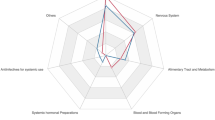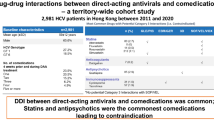Abstract
Background
The potential for clinically significant drug interactions (CSDIs) for patients taking ritonavir and cobicistat is high because of their powerful pharmacokinetic effect on the cytochrome P450 (CYP) enzyme system, most notably their inhibitory effect on CYP3A4.
Aims
An audit was conducted to measure and correct for patients exposed to potentially dangerous drug interactions.
Methods
Two hundred individuals attending a regional specialist human immunodeficiency virus (HIV) clinic between June and September 2014 who were receiving the pharmacokinetic enhancers ritonavir or cobicistat were interviewed to determine a medication history including medications prescribed by their general practitioner (GP), over-the-counter (OTC) medicines, herbal remedies and recreational drugs.
Results
Of the 200 patients interviewed, patients were aged 23–76 years (median age was 41.5), 64% were female and 173 reported taking a co-medication. Sixty-six (33%) were taking a medication or medications which had no significant drug interaction associated with them. One hundred and seven (54%) were taking one or more medications with a CSDI which could require a dose adjustment, close monitoring or an absolute contraindication. Only 27% of these co-medications were identified in the normal course of an outpatient visit outside of the audit.
Conclusion
A detailed medication history is often lacking at routine HIV follow-up visits. There is a significant risk of CSDIs in this cohort. Awareness of physicians and pharmacists needs to be raised. Implementation of several innovative strategies to capture the most accurate medication histories and avoid drug toxicities now employed in this cohort is also discussed here.



Similar content being viewed by others
References
Effros RB, Fletcher CV, Gebo K et al (2008) Workshop on HIV infection and aging: what is known and future research directions. Clin Infect Dis 47(4):542–553
Vance DE, Mugavero M, Willig J et al (2011) Aging with HIV: a cross sectional study of comorbidity prevalence and clinical characteristics across decades of life. J Assoc Nurses AIDS Care 22(1):17–25
Shah SS, McGowan JP, Smith C, Blum S, Klein RS (2002) Comorbid conditions, treatment, and health maintenance in older persons with human immunodeficiency virus infection in New York City. Clin Infect Dis 35(10):1238–1243
Gore-Felton C, Vosvick M, Power R, Koopman C, Ashton E, Bachmann MH, Israelski D, Spiegel D (2003) Alternative therapies: a common practice among men and women living with HIV. J Assoc Nurses AIDS Care 14:17–27
Evans-Jones JG, Cottle LE, Back DJ, Gibbons S, Beeching NJ, Carey PB, Khoo SH (2010) Recognition of risk for clinically significant drug interactions among HIV-infected patients receiving antiretroviral therapy. Clin Infect Dis 50(10):1419–1421
Marzolini C, Elzi L, Gibbons S, Weber R, Fux C, Furrer H, Chave JP, Cavassini M, Bernasconi E, Calmy A, Vernazza P, Khoo S, Ledergerber B, Back D, Battegay M, Swiss HIV Cohort Study (2010) Prevalence of comedications and effect of potential drug-drug interactions in the Swiss HIV Cohort study. Antivir Ther 15:413–423
British HIV Association guidelines for the treatment of HIV-1-positive adults with antiretroviral therapy 2015 (2016 interim update) available at: www.bhiva.org/HIV-1-treatment-guidelines.aspx (accessed September 2016)
Liverpool HIV Drug Interactions Website. www.hiv-druginteractions.org (accessed June 2014)
Directive 2004/24/EC of the European Parliament and of the Council of 31 March 2004, amending, as regards traditional herbal medicinal products, Directive 2001/83/EC on the Community code relating to medicinal products for human use. Official Journal of the European Union 2004; April 4 :L 136/85 available at ec.europa.eu/health/human-use/herbal-medicines/index_en.htm (accessed September 2016)
Gilroy CM, Steiner JF, Byers T, Shapiro H, Georgian W (2003) Echinacea and truth in labelling. Arch Intern Med 163:699–704
Warning on various sexual enhancement products marketed as dietary supplements, manufactured by Atlas Operations Inc. Notice information-Warning 23 December 2009. Health Products Regulatory Authority: QDR-H-09-572 available at www.hpra.ie/homepage/medicines/saftey-notices (accessed September 2016)
Li Da Dai Dai Hua Capsules. Notice Information: Human Medicines -Warning 22 September 2008. Health Products Regulatory Authority: QDR-H-08-375. available at www.hpra.ie/homepage/medicines/saftey-notices (accessed September 2016)
Flovent HFA Inhalation aerosol (fluticasone propionate). GlaxoSmithKline. US Prescribing Information, September 2016 available at www.gsksource.com/floventhfa (accessed September 2016)
Foisy MM, Yakiwchuk EMK, Chiu I, Singh AE (2008) Adrenal suppression and Cushing's syndrome secondary to an interaction between ritonavir and fluticasone: a review of the literature. HIV Med 9:389–396
Bristol-Myers Squibb Pharmaceutical Limited, 23/06/2016. Summary of product characteristics Reyataz 150 mg, 200 mg and 300 mg hard capsules. Available at www.medicines.ie/medicine/7553 (accessed September 2016)
Antoniou T, Tseng AL (2002) Interactions between recreational drugs and antiretroviral agents. Ann Pharmacother 36:1598–1613
Littlewood RA, Vanable PA (2008) Complementary and alternative medicine use among HIV + people: research synthesis and implications for HIV care. AIDS Care 20(8):1002–1018
Funding
This work was conducted by the infectious diseases team. No additional funding for this work has been received.
Author information
Authors and Affiliations
Contributions
PH designed the study, collected and analysed the data and wrote the first draft of the manuscript EdeB, SMcC designed the study and edited the manuscript, RMacC, and DL collected the data. All authors reviewed and approved the final version of the manuscript.
Corresponding author
Ethics declarations
The authors declare that they have no conflict of interest.
Ethical standards
Beaumont Hospitals’ audit review board deemed the study a review of service provision. All procedures which were performed in studies involving human participants were in accordance with the ethical standards of the institutional and/or national research committee and with the 1964 Helsinki declaration and its later amendments or comparable ethical standards.
Informed consent
Informed consent was requested from all individual participants included in the study.
Additional information
Publisher’s note
Springer Nature remains neutral with regard to jurisdictional claims in published maps and institutional affiliations.
Rights and permissions
About this article
Cite this article
Hollywood, P., MacCann, R., Lorigan, D. et al. Pharmacokinetic enhancers (cobicistat/ritonavir) and the potential for drug-drug interactions. Ir J Med Sci 189, 693–699 (2020). https://doi.org/10.1007/s11845-019-02125-1
Received:
Accepted:
Published:
Issue Date:
DOI: https://doi.org/10.1007/s11845-019-02125-1




